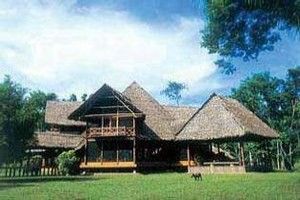 |
| The Amazon Pavilion is the main lodge and an example of daring
architecture. The central palm-thatch circular roof stands with
no central column over a single, tree trunk axle with wood spikes
39 feet long radiating from it like a huge umbrella. |
|
Reserva
Amazonica is a privately-owned ecological reserve and research center
on 10,000 hectares (24,710 acres), practicing innovative, sustainable
use of the Amazon Rainforest since 1975. Scientific-based tourism started
in 1978. Its spacious facilities and well-equipped private cabins assure
guests an authentic, safe, and comfortable stay.
Fly east from Lima or Cuzco to Puerto Maldonado, situated at
the confluence of the mighty Madre de Dios and Tambopata Rivers. It
is a bustling, tropical frontier town, and its principal activities
are gold mining, Brazil nut collecting, timber extraction, agriculture,
and ecotourism. The
lodge is five kilometers (one hour) downriver by boat from the city.

The
average temperature is between 84° F and 100° F. December to
March is usually hotter, with an occasional refreshing afternoon rainfall.
The rest of the year, with less rain and more sun, is another good time
to see the jungle. Occassionally, there is a sudden drop in temperature
known as a friaje, which can dip to 50° F.
The
lodge has 41 large, comfortable, private bungalows with
grand views of the Madre de Dios River and the surrounding, noisy rainforest. Local materials were used to build them in the architectural style of
the native Machiguenga and Ese'eja people. The
cabins sit on raised platforms and have pitched palm-thatch roofs and
large screened windows for optimal ventilation.
Local materials were used to build them in the architectural style of
the native Machiguenga and Ese'eja people. The
cabins sit on raised platforms and have pitched palm-thatch roofs and
large screened windows for optimal ventilation.
|
|
Superior Bungalow
(mouseover for sample floor plan)
|
All
cabañas feature three areas: a private terrace with woven hammocks,
a bedroom (with beds surrounded by mosquito netting), and a private bathroom
with filtered water. They are attractively furnished with log chairs,
a writing table, umbrellas, lanterns, kerosene lamps, and a full set of
amenities, including natural shampoo in blown-glass bottles, clay exfoliator,
hand-made soap, and over-sized towels.
Superior Bungalows provide comfortable,
basic accommodation with two twin beds or one double bed, a writing
table, a private porch with two hammocks and a private bathroom and
clear running water. Room size is approximately 29 mt² (313 ft²).
|
|
Riverview Cabin Porch
(mouseover for sample floor plan)
|
|
|
Amazonian Suite
(mouseover for sample floor plan)
|
Riverview Cabins are approximately 41 mt²
(434 ft²), with larger porches
facing the river, two double beds, solar-heated hot water, electricity
and fans. The room has separate shower and toilet. House amenities also
include citronella repellents, terry cloth bathrobes, and typical Andean
sandals.
Amazonian Suites are
extra-large, approximately 60 mt² (646 ft²), more comfortable
cabañas with either one king-sized bed or two double beds. The
room has separate shower and toilet with double washbasins, walk-in
closet, solar-heated hot water, electricity and fans. House amenities
also include citronella repellents, terry cloth bathrobes, and typical
Andean sandals and two hammocks.
|
|
Tambopata Suite
(mouseover for sample floor plan)
|
Tambopata Suites
Authentic Ese’eja-style wooden cabañas
approximately 78 mt² (840 ft²), divided into four integrated
areas and covered by a high palm-thatched roof. The private covered
terrace comes with a plunge pool, two sunbathing chairs and an outside
shower with a private service entrance. The generous bedroom has one
king or two twin beds canopied with mosquito netting, 100% cotton sheets,
six hypoallergenic pillows, bathrobes, and Andean rubber slippers. The
open plan bathroom comes complete with double walk-in closet; has an
independent shower and toilet; double basins; hot water; large towels;
and a complete set of extra large, ecologically friendly toiletry including:
bath salts, neutral shampoo, conditioner, terracotta exfoliates, hand
made soaps, and citronella natural repellent. Also, the cabaña
features a siesta lounge with two hammocks, two comfortable wooden chairs,
and a side table. Each suite is equipped with umbrellas, flash lights,
kerosene lamps for lighting, central ceiling ventilator, and an electric
outlet. Guests in the Tambopata Suites are accompanied from the airport
to the lodge by a personal escort.
Day 1 - Fly Cuzco to Puerto
Maldonado
Meeting service upon arrival at the airport
in Puerto Maldonado.
Survey this bustling, jungle frontier town on the confluence of the
Madre de Dios
and Tambopata Rivers.
Then, commence a one-hour journey by motorized
dugout canoe on the Madre de Dios River.
During the trip, you may see bird species typical of the river's edge,
such as: 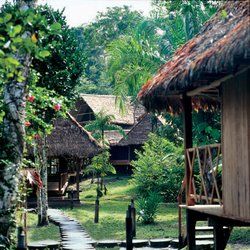 Black
Skimmer, Pied Lapwing, Capped Heron, Horned Screamer, Bat Falcon, and
several species of kingfishers, swallows, and flycatchers.
Arrive at the lodge in time to unpack, unwind, and enjoy lunch. You
will receive a short orientation and a complete briefing of the lodge
and the Ese'eja Ecotourism Project
over dinner. (L, D) Black
Skimmer, Pied Lapwing, Capped Heron, Horned Screamer, Bat Falcon, and
several species of kingfishers, swallows, and flycatchers.
Arrive at the lodge in time to unpack, unwind, and enjoy lunch. You
will receive a short orientation and a complete briefing of the lodge
and the Ese'eja Ecotourism Project
over dinner. (L, D)
Days 2 & 3 (depending
upon safari length): At Reserva Amazonica
Have a buffet breakfast(s) at the lodge before
starting out on your daily excursion. Ride twenty minutes by motorboat
to the right bank of the Madre
de Dios River, and then walk
for about an hour through the tropical rainforest.
During the three-kilometer stretch, see plants, trees, some Batrachia
(toads and frogs) and reptiles, a variety of birds and, throughout the
whole walk, dancing multi-colored butterflies. At the end of the path,
glide through the marsh in a rowboat to solitary, magnificent Lake
Sandoval. Here, take in the extraordinary
sight of placid waters surrounded by palm, aguaje and other primary
forest trees. During the journey, observe also rich flora and fauna
including river otters, caimans
(alligators), turtles, Amazonian birds including the hoatzin or shansho
(a prehistoric-looking bird, Opithocamus hoazin or stinkbird), parrots,
Black Skimmers, and herons.
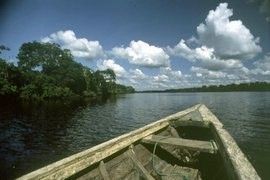 Return
to Madre de Dios to board the motor boat for a brief ride followed by
a five-minute walk through the wet forest among plantings of cacao trees,
coffee bushes, and other plants. Return
to Madre de Dios to board the motor boat for a brief ride followed by
a five-minute walk through the wet forest among plantings of cacao trees,
coffee bushes, and other plants.
At the end of the trail, discover
the famous paddle-wheel boat, Fitzcarraldo,
run aground many years ago and covered with vegetation. This boat was
used in the past as an itinerate hospital to serve indigenous communities.
Return to the lodge by boat for another delicious lunch in the panoramic
dining room, then time out for a nap.
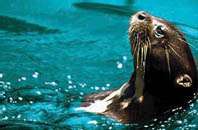 |
|
River Otter on Lake
Sandoval |
In the afternoon, visit an indigenous
cultivation plot to view various Amazonian crops and observe
the local community's lifestyle. Enjoy the opportunity to
taste some tropical fruits and edible plants such as sugar cane, yucca
(cassava), bananas, and cacao (coco). Return to the lodge at
sunset, the ideal time to photograph the fusion of river and sky in
soothing colors. A typical dinner will be served tonight, PACA (fish,
chicken, or meat prepared on a bamboo skewer and cooked over the coals,
rice with cooked tomatoes and onions, and a variety of exotic herbs
and sauces). The PACA is prepared outside the main dining room and according
to local practice. (B, L, D)
Days
3 or 4 (depending upon safari length): Fly Puerto Maldonado to Lima
Rise and breakfast early this morning before your transfer to Puerto
Maldonado airport, where you will be assisted with check-in for your
flight to Lima. (B)
The Tambopata rainforest holds world records in biodiversity,
and Reserva Amazonica has more than 200 species of native plants with
different curative properties. In
an area of only 1,000 square meters, visitors can observe over 500 species
of native birds, which is comparable to the number of species existing
in all of North America. A new, U.N. sponsored ACEER research center
and canopy walkway has also been installed on the grounds of the Reserva
Amazonica.
The Reserva Amazonica Trails System includes four clearly-cut
trails and extends across roughly 8 kilometers (5 miles) of the lodge's
surrounding rainforest, providing access to the various Amazon habitats:
seasonably flooded forests and groves, Amazon palms, and primary and
secondary forests, among others. The trails vary in length and level
of difficulty. A walk could last one or two hours, depending on the
tour selected. In order to make the least possible impact on the environment,
availability of the trails can change depending on the frequency of
use. It is recommended that you walk slowly and carefully, listen, smell
the air, talk softly, stop often and look up, thereby magnifying your
senses in order to take in the surrounding views and sounds. Small groups
are always better than large ones. A selection from the following excursions
is also included: The
Rainforest by Night (1.5 hours), Rolin
(Monkey) Island (2 hours), the Butterfly
Farm (1 hour), Madre
de Dios River by Night (2 hours), Lake
Sandoval (half day), Native
Amazonian Farm (3.5 hours), Gamitana
Creek (half day), Ese'eja Native Community
(2 hours), and Inkaterra
Canopy and Wetlands (3 hours).
The Trail System includes:
Oje Trail - Duration: 1 hour:
Oje Trail allows the visitor to appreciate the diversity of the Amazon
rainforest palms and trees such as Oje (Ficus insipida), Catahua (Hura
crepitans), Ceiba (Ceiba pentandra) and Huito (Genipa americana), specially
used for body coloring. The Oje Trail covers mainly riverside and seasonally
flooded forests, is 1.8 km (1.1 miles) long, features well-marked shortcuts,
and ranks as the most accessible of our trails. Visitors are escorted
along the trail by a resident guide.
Lupuna
Trail - Duration: 3 hours: Lupuna
Trail covers a greater variety of ecosystems, from seasonably flooded
groves and virgin forests to stream banks. The habitat of the stream
area is particularly propitious for bird and butterfly viewing. The
highlight of this trail, which is 2.1 km (1.3 miles) long, is the roughly
200-year old Lupuna Tree (Ceiba pentandra). There are some permanently
muddy areas along the trail, ideal for sighting footprints of the most
elusive wildlife, such as the Red Brocket Deer (Mazama Americana) and
the Collared Peccary (Tayassu tajacu). Visitors may also spot other
species such as the Sachavaca (a large tapir) and trees such as the
Capirona (Calycophy spruceanum), Ceiba (Ceiba pentandra) or Kapok Tree
and Shihuahuaco (Dipteryx micrantha) or "Iron tree." A guide
is recommended although the path is marked every 50 meters.
(Both Oje and Lupuna Trails are loop-trails retracing steps.)
Swamp
Trail - Duration: 3 hours: This
worthwhile non-loop trail is an extension of Lupuna Trail and also features
various habitats. Visitors who wish to get more involved with the Amazon's
floodable ecosystem and biodiversity should not miss this trail. This
trail is not included in the Discovering Tambopata excursion.
Aguaje
Palm Trail - Duration: 4 hours:
Aguaje Palm Trail (1.5 km or 0.9 mille) leads to sunken palm groves
known as aguajales of Aguaje palms (Maurita flexuosa). Exotic fruit
juices and savory palmettos are obtained from these majestic palms.
In November these palms are laden with fruit, which in turn attract
many birds and curious mammals such as deer, peccaries, monkeys and
tapirs (Tapirus terrestris). This trail is not included in the Discovering
Tambopata excursion.
Venturing into the rainforest after dark enables visitors to listen
to nocturnal forest sounds and spot Amazon species that only emerge
at night, such as tarantulas, armadillos and even ocelots. A guide and
a powerful flashlight are required.
Duration: 1 hour and 30 minutes.
 Rolin
Island (also known as Monkey Island), located in the Madre de Dios River,
is a large property in front of RESERVA AMAZÓNICA. In association
with INRENA PERU (National Institute of Natural Resources), INKATERRA
runs a conservation project to protect endangered primates and reintroduce
them to their natural environment. This lush island is unique to the
area and a favorite excursion destination for RESERVA AMAZÓNICA
guests. Hiking trails, huge trees, and beautiful beaches in summer that
embellish the isle scenery. Rolin is a special location to watch particular
monkey species such as the white fronted capuchin, the brown capuchin,
the saddle backed tamarin and the squirrel monkey. Rolin
Island (also known as Monkey Island), located in the Madre de Dios River,
is a large property in front of RESERVA AMAZÓNICA. In association
with INRENA PERU (National Institute of Natural Resources), INKATERRA
runs a conservation project to protect endangered primates and reintroduce
them to their natural environment. This lush island is unique to the
area and a favorite excursion destination for RESERVA AMAZÓNICA
guests. Hiking trails, huge trees, and beautiful beaches in summer that
embellish the isle scenery. Rolin is a special location to watch particular
monkey species such as the white fronted capuchin, the brown capuchin,
the saddle backed tamarin and the squirrel monkey.
Duration:
2 hours
Access: Motorized boat and by foot
Guests can visit the butterfly farm at Puerto Maldonado and observe
the captivating beauty and vast diversity of native butterfly. Peru
boasts the greatest number of observable butterfly species in the world.
Duration:
1 hour
Access: By car (next to the airport)
This expedition gives visitors the opportunity to spot eye-catching
caimans at the river beaches hunting for their prey. Madre de Dios River
is home to three species of alligators: black caiman, white caiman and
the dwarf caiman (right). Capibaras (Hydrochaeris hydrochaesis), the
biggest rodent on earth, can also be spotted during this expedition.
Duration:
2 hours
Access: Motorized boat
Visiting the isolated Lake Sandoval, the most beautiful at the Tambopata
Reserve, is a unique excursion not to be missed. It gives the traveler
the chance to get close to various animal species such as the "Shansho"
(or Opisthocomus Hoatzin bird), parrots and other birds, turtles, piranhas,
and maybe even the giant otter of the Amazon. Lake Sandoval is an extraordinary
waterbody, rich in icthiological species, surrounded by Moriche palm
trees (Mauritia flexuosa). A paddle boat ride around the lake exposes
its rich fauna and flora.
Duration:
Half day
Access: Motorized boat, by foot
and paddle boat.
Note: Full-Day journeys to the
lake are available at an additional cost.
Visitors explore typical local farms (or chacras) where locals show them
a wide variety of Amazon crops and their lifestyles. They are able to
sample regional fruits (such as papaya, cocona, chirimoya and several
varieties of bananas) and appreciate other local species (such as hierba
luisa, sugar cane, cassava and cocoa).
Duration:
3 hours and 30 minutes
Access: Motorized boat and by foot
Visitors board a motorboat and travel upstream to the marvelous and
calmed Gamitana Creek. In this exploration the travelers are able to
sight birds, monkeys, caimans and turtles, and enjoy a day of fishing.
Lunch includes tasty Amazon fish served in one of the creek's beaches.
Also, visitors may have the option of paddling in local canoes.
Duration:
Half day
Access: Motorized boat, canoe and
by foot
|
This spectacular activity, unique to RESERVA AMAZÓNICA in the
Madre de Dios region,allows
visitors to appreciate theAmazon from a unique perspective and to observe
theflora and fauna of the treetops. At 40 meters (130 feet) above the ground, guests can walk and explore more than 320 meters (1050 feet)
of treetops, observing orchids, diverse fruits, insects and a large
variety of tree-dwelling animals. The Canopy Walkway features two observation
towers and several circular observation platforms.
Duration: 3 hours
Access: Foot
|
The following Activities are part
of our explorations:
 |
Footprints
Identify animal prints and learn to interpret them during your excursions.
|
 |
Birdwatching
Spot and identify some of the 550 different species of birds that
reside in the Madre de Dios region. 355 types have been spotted
in Inkaterra´s Ecological Reserve. |
 |
Survival Skills
Experiment some of the most useful survival skills used among natives.
Learn to use the longbow and the blowgun, to recognize which animals
and plants are edible and to identify local sounds, among other
techniques. |
 |
Fishing
Use local fishing techniques, identify the most popular fishes in
the Madre de Dios region, and if you wish, try their flavors. |
 |
Photography
Find picture opportunities in this photographic paradise.
|
 |
Medicinal Plants
Scout the world of medicine from a native´s perspective. It
has been calculated that natives use more than 4000 different types
of plants for medical purposes, from which only 40% have been scientificaly
investigated.
|
 |
Astronomy
Discover the astounding southern hemisphere, using special equipment.
|
 |
Tracking Ants
Identify different Amazon ant species and learning about their team-based
working system, as well as understanding the importance of ants
in the Amazon ecosystem. During his work at RESERVA AMAZÓNICA,
Harvard Professor Edward O. Wilson registered the world record of
ant species in a single location (362 species). |
|



 Local materials were used to build them in the architectural style of
the native Machiguenga and Ese'eja people. The
cabins sit on raised platforms and have pitched palm-thatch roofs and
large screened windows for optimal ventilation.
Local materials were used to build them in the architectural style of
the native Machiguenga and Ese'eja people. The
cabins sit on raised platforms and have pitched palm-thatch roofs and
large screened windows for optimal ventilation.
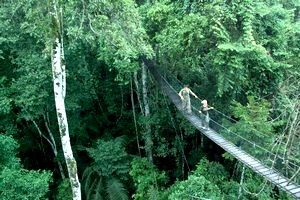 Ecology
Ecology Butterfly
Farm
Butterfly
Farm